John Holland Jewel Inlaid Pearl and Black Stripe c. 1937-1939
by Jim Mamoulides, June 11, 2003, updated November 18, 2017
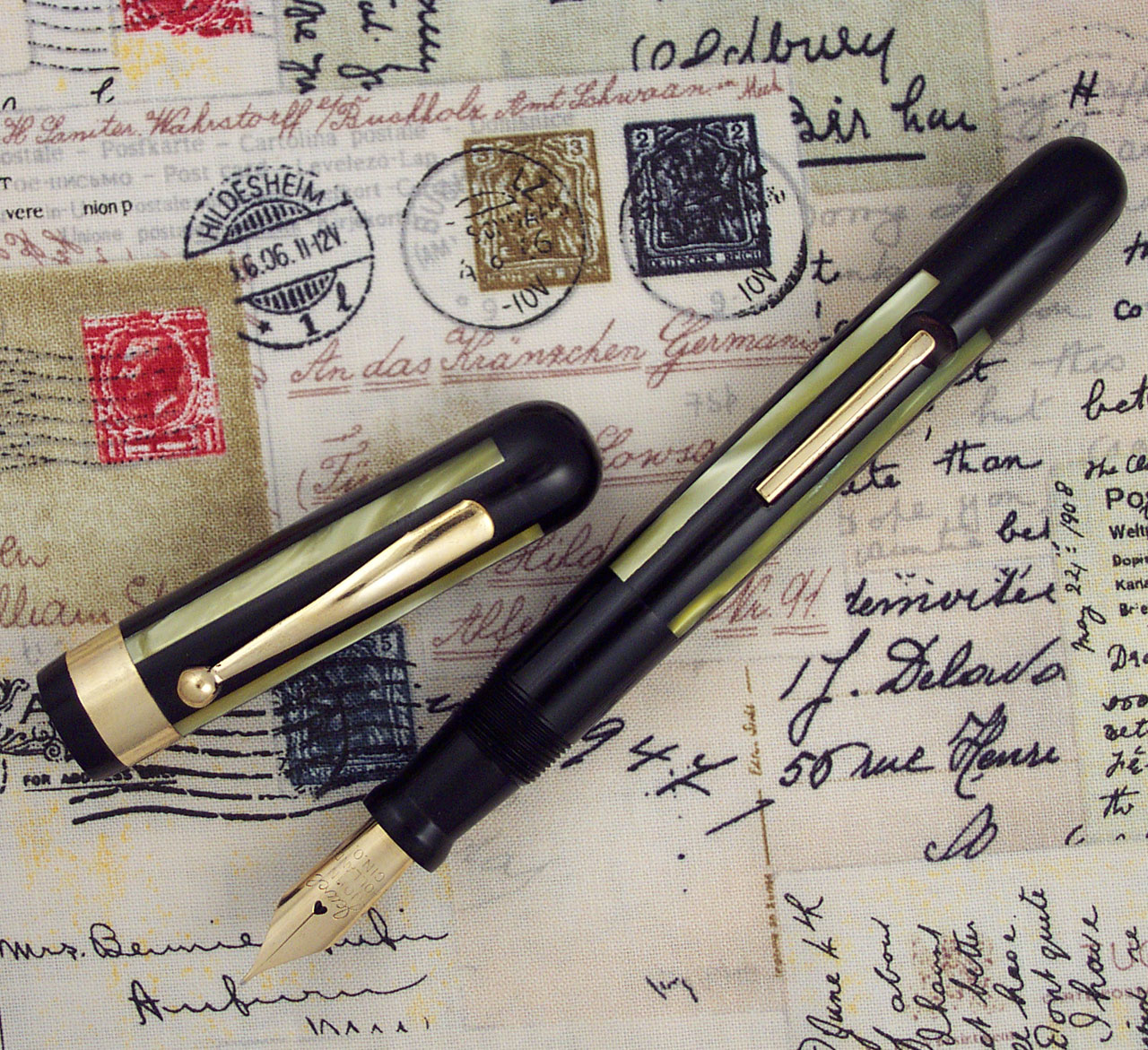 John Holland Jewel Inlaid Pearl and Black Stripe c. 1937
John Holland Jewel Inlaid Pearl and Black Stripe c. 1937
A jewel of a pen
The John Holland Gold Pen Company was a regional pen manufacturer in Cincinnati, Ohio that was founded by its namesake in 1841 as a manufacturer of gold pen nibs for dip pens. The company continued in business adding the manufacturing of pen holders in 1869, and complete fountain pens, until operations ceased in about 1950. The company touted the quality of its Jewel nibs by advertising that they could withstand a "drop-test" on the point from six feet. John Holland is noted by collectors for the interesting, but unsuccessful "hatchet" filler, hand painted pens, and unusual plastic design pens.
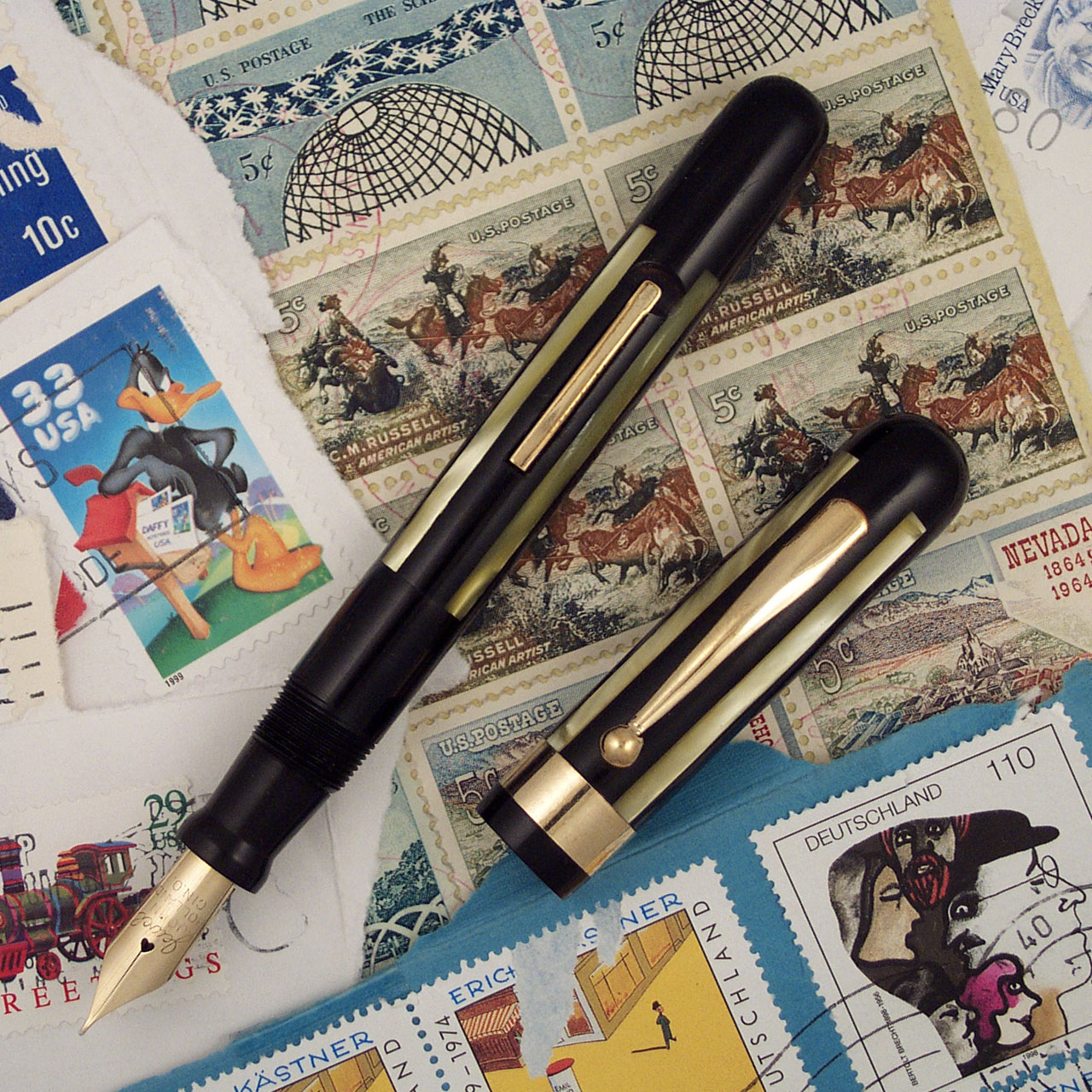 John Holland Jewel Inlaid Pearl and Black Stripe c. 1937
John Holland Jewel Inlaid Pearl and Black Stripe c. 1937
This full size Inlaid Pearl and Black Stripe fountain pen is the very first John Holland I've had the pleasure to write with. The pen was found in a large Cincinnati indoor antique mall, and probably never left the Cincinnati area in its life, until now. Other than the large and long tined John Holland Jewel nib, there are no markings anywhere on this pen to identify it. The same goes for the ringtop pen, shown below.
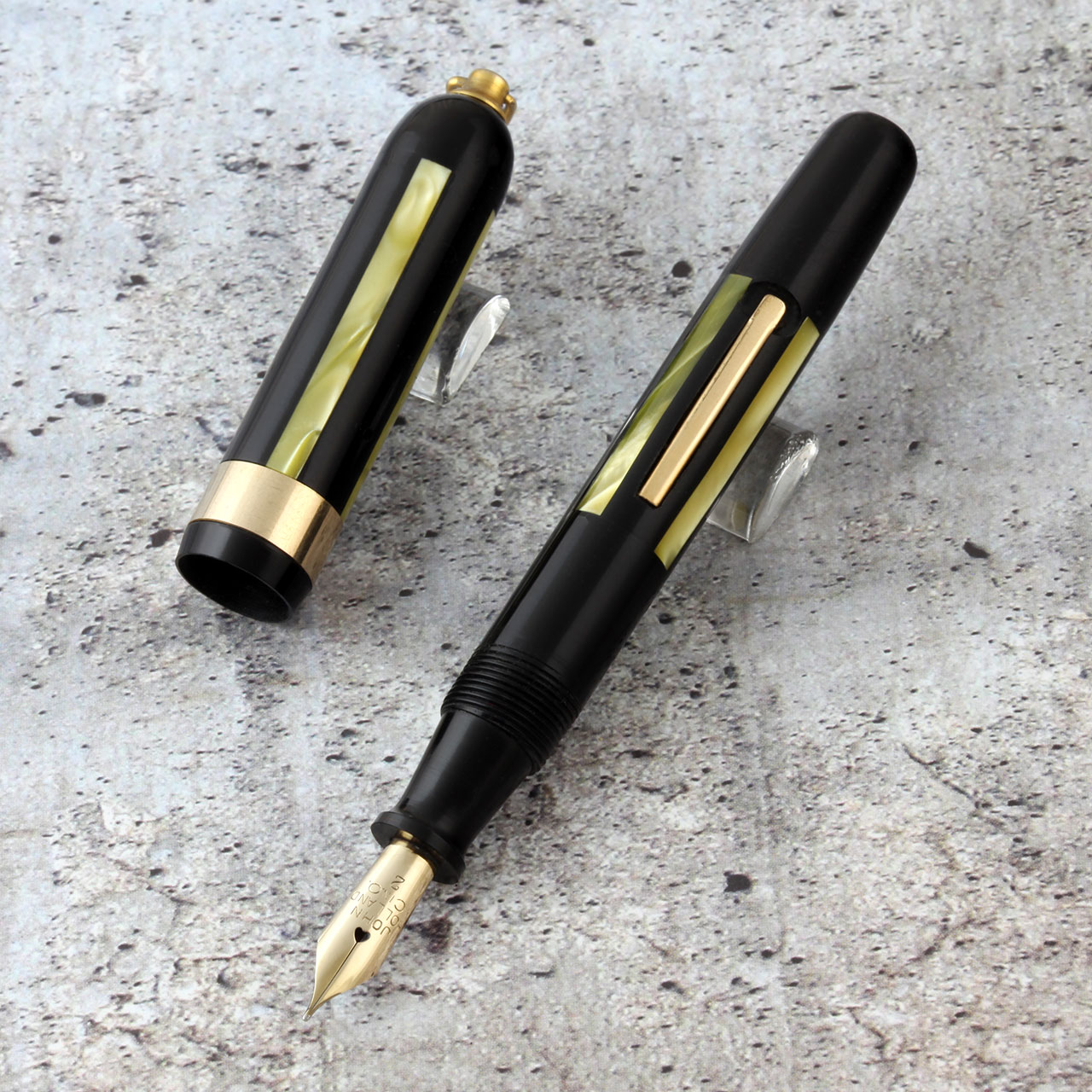 John Holland Jewel Inlaid Pearl and Black Stripe ringtop c. 1937, open
John Holland Jewel Inlaid Pearl and Black Stripe ringtop c. 1937, open
There are very limited catalog and pricing resources available on John Holland pens. John Holland advertised frequently and I have found examples as early as 1894. The Jewel name appears on John Holland pen nibs at least as early as the early 1920s. The Jewel name is associated with the entire pen by 1939.
 John Holland Jewel Inlaid Pearl and Black Stripe c. 1937, open and closed, with inset showing the tulip shaped logo at the cap top
John Holland Jewel Inlaid Pearl and Black Stripe c. 1937, open and closed, with inset showing the tulip shaped logo at the cap top
This pen, being modestly streamlined, dates it post-1929, after the Sheaffer Balance was introduced, a pen that shocked the pen world away from the existing tubular flattop designs into a more modern, streamlined style. My experience with John Holland streamlined pens indicates that the company was not always consistent with clips, barrel imprints or use of the tulip shaped John Holland logo either stamped into or inlaid into the top face of the cap. The one consistent element is the Jewel nib.
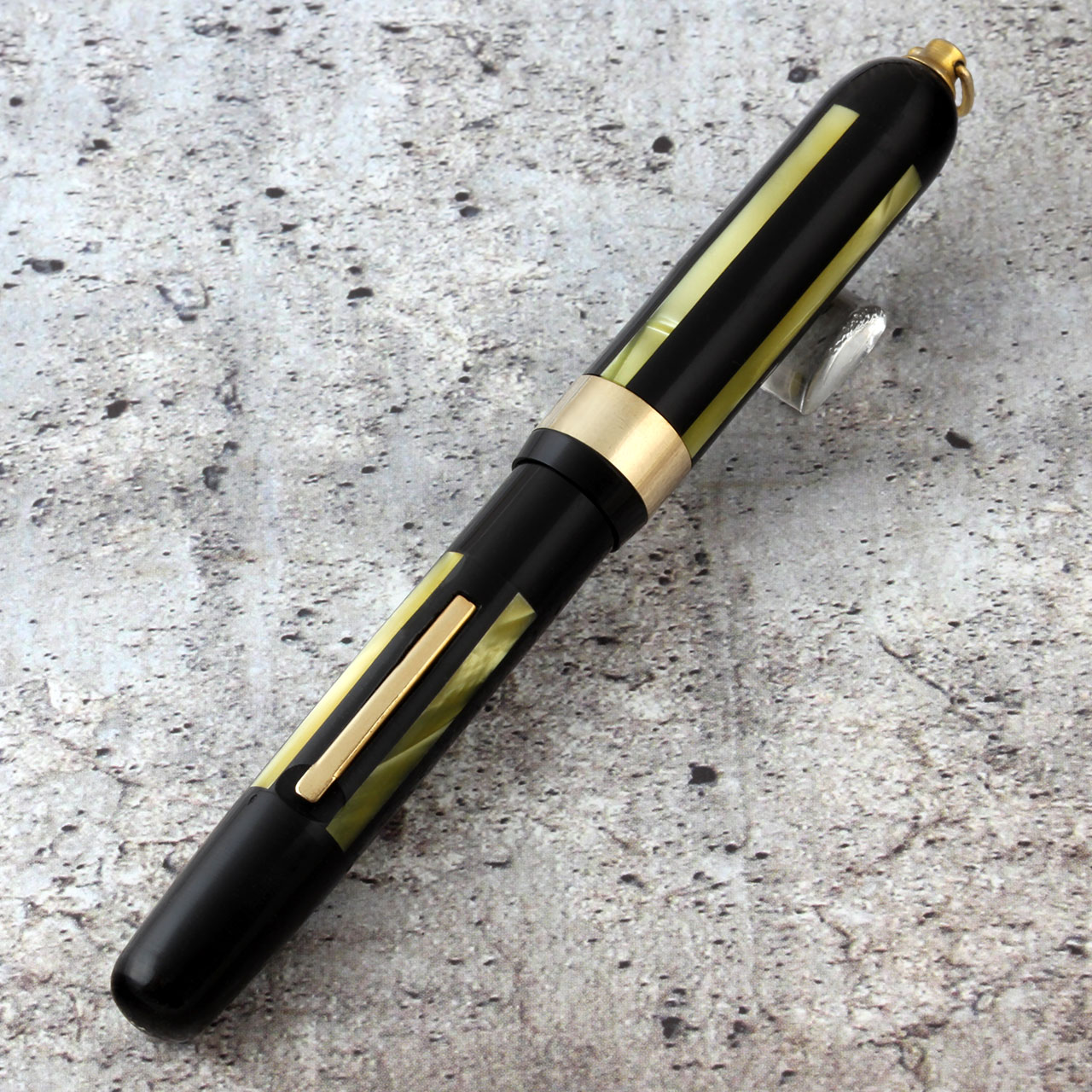 John Holland Jewel Inlaid Pearl and Black Stripe ringtop c. 1937, closed
John Holland Jewel Inlaid Pearl and Black Stripe ringtop c. 1937, closed
L. Michael Fultz wrote a short history of John Holland for PenBid that includes this statement, which may explain these variations:
The Great Depression was very difficult for Holland, which entered the business downturn with limited capital and fewer resources than its competitors. After 1930, the quality of Holland pens is much lessened but the company carried on into World War Two. Pens are assembled from purchased parts with nibs drawn from old stocks. Profits, if any, were mainly derived from the office supply business conducted on the ground floor of the Holland building. - "History of John Holland," by L. Michael Fultz, Luxbid.com
Given the financial situation of the company in the 1930s, some variability in the product can be understood. Many pen manufacturers were struggling to stay alive and became inconsistent in production, which only serves to frustrate later collectors trying to identify and classify their finds. John Holland maintained high quality standards during this period, and this pen proves no exception.
A unique design
The pen barrel and cap appear to each be made from three separate pieces that are probably glued together. The two end sections of the cap and barrel are a rounded solid black plastic. The center is a tube of alternating wide black and narrow faux mother of pearl strips and given the name, the pearl elements may be inlaid. This mid-section is visually well centered on each piece, and also done so that these segments show in balance with the pen capped. After this inlaid section on each piece is the solid black cap lip with cap band and the threaded black barrel top. The ball end clip is fastened to the front of the cap. The pen must have been more costly to make as the $9.60 price in 1937 and 1939 was $3.20 higher than other all plastic Number 3 pens.
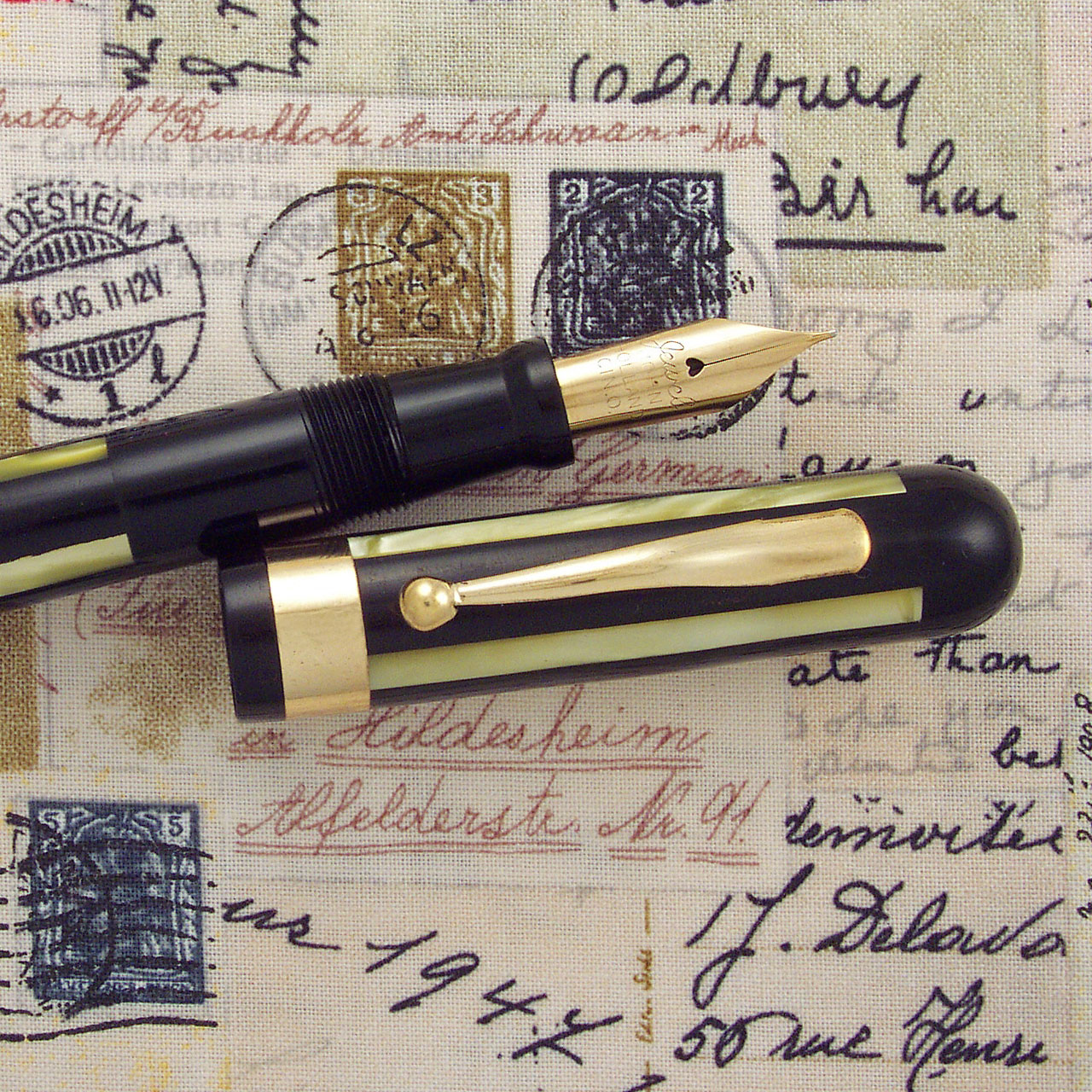 John Holland Jewel Inlaid Pearl and Black Stripe c. 1937
John Holland Jewel Inlaid Pearl and Black Stripe c. 1937
A ringtop, too!
After this article was originally published, I received a scanned image from Naphtali Hoffman of a very similar John Holland Jewel pen, except this is a ringtop pen with a clip. Although the pen is the same design, the clip is completely different, lending more credence to John Holland's dependence on jobbed parts.
 John Holland Jewel Inlay ringtop pen c. 1937 - Image courtesy Naphtali Hoffman
John Holland Jewel Inlay ringtop pen c. 1937 - Image courtesy Naphtali Hoffman
Later, I was able to acquire for photos one of the standard ringtop pens, and added it to the article.
Identification guide and features:
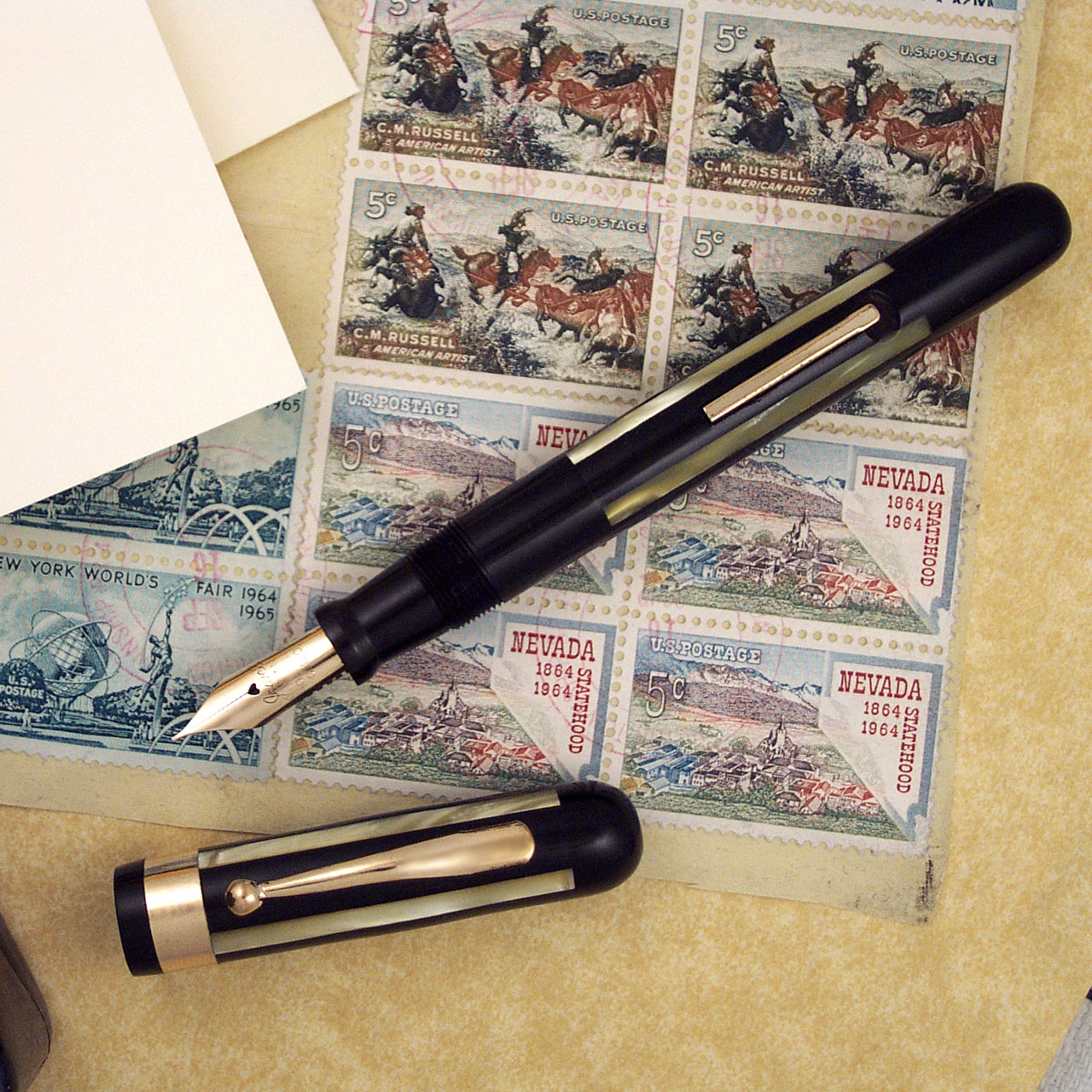 John Holland Jewel Inlaid Pearl and Black Stripe c. 1937
John Holland Jewel Inlaid Pearl and Black Stripe c. 1937
I've only seen two sets of catalog pages showing this pen and it's not John Holland's own, but an unnamed retail catalog from 1937 and 1939 using John Holland's images and descriptions. The pens shown in this article match the illustrations from the 1937 catalog. Key differences are the 1939 catalog pages show a visible ink view section on the pens and the pens have the John Holland tulip logo inlay in the cap top, above the clip on clip pens. Given this information, I'm dating the three pens shown c. 1937. It's possible the line could have started earlier, but there is no catalog or advertisement evidence at this time.
What we do know is the catalog name is Pearl and Black Stripe in 1937 and Inlaid Pearl and Black Stripe in 1939 and was sold in three versions, a full size pen with a Number 3 nib and two ringtop pens, with or without a clip, and with a Number 2 nib. The retail price for the full size, or "medium" pen was $9.60, and the ringtop was $6.40. The retail price for the full size pen and pencil set in 1937 was $16.00 and in 1939 was $16.25. The ringtop pen and pencil set was $10.90.
- Cap and barrel made from black plastic with black and pearl inlay strips design
- Gold plated trim
- Nib grades unknown, but would expect a full range from extra fine, fine, medium, coarse, and stub given cataloged nib grades
- Lever-fill mechanism
- Sold in paperboard boxes
Full size fountain pen
- Plain faced ball end clip
- Number 3 size 14 karat gold nib marked "Jewel" over "JOHN" over "HOLLAND" over "CIN. O."
- 5 1/4 inches long capped, 6 1/8 inches long with the cap posted on the end of the barrel
- Retail price was $9.60, matching pencil in 1937 was $6.40, $6.45 in 1939
Ringtop fountain pen
- Number 2 size 14 karat gold nib marked "JOHN" over "HOLLAND" over "CIN. O."
- 4 1/2 inches long capped, 5 1/2 inches long with the cap posted on the end of the barrel
- Retail price was $6.40, matching pencil was $4.50
 John Holland Jewel Inlay ringtop pen c1939 catalog image
John Holland Jewel Inlay ringtop pen c1939 catalog image
Changes in design from 1937 to 1939:
- Cap top more pointed
- Pearlized inlay (a John Holland trademark) added in cap top face, above clip on clip pens
- Ringtop model with clip added, same price
- Arrow clip with a flat faced ridge down the middle top to bottom
- Clear "Ink-Vis" section
Performance
I wrote and wrote and wrote with the full size pen. I have to say up front, as this was not my pen and I was specifically asked not to fill it, as it was destined for sale (already sold), I still had more fun dipping and writing with it than with many other pens I have tried out.
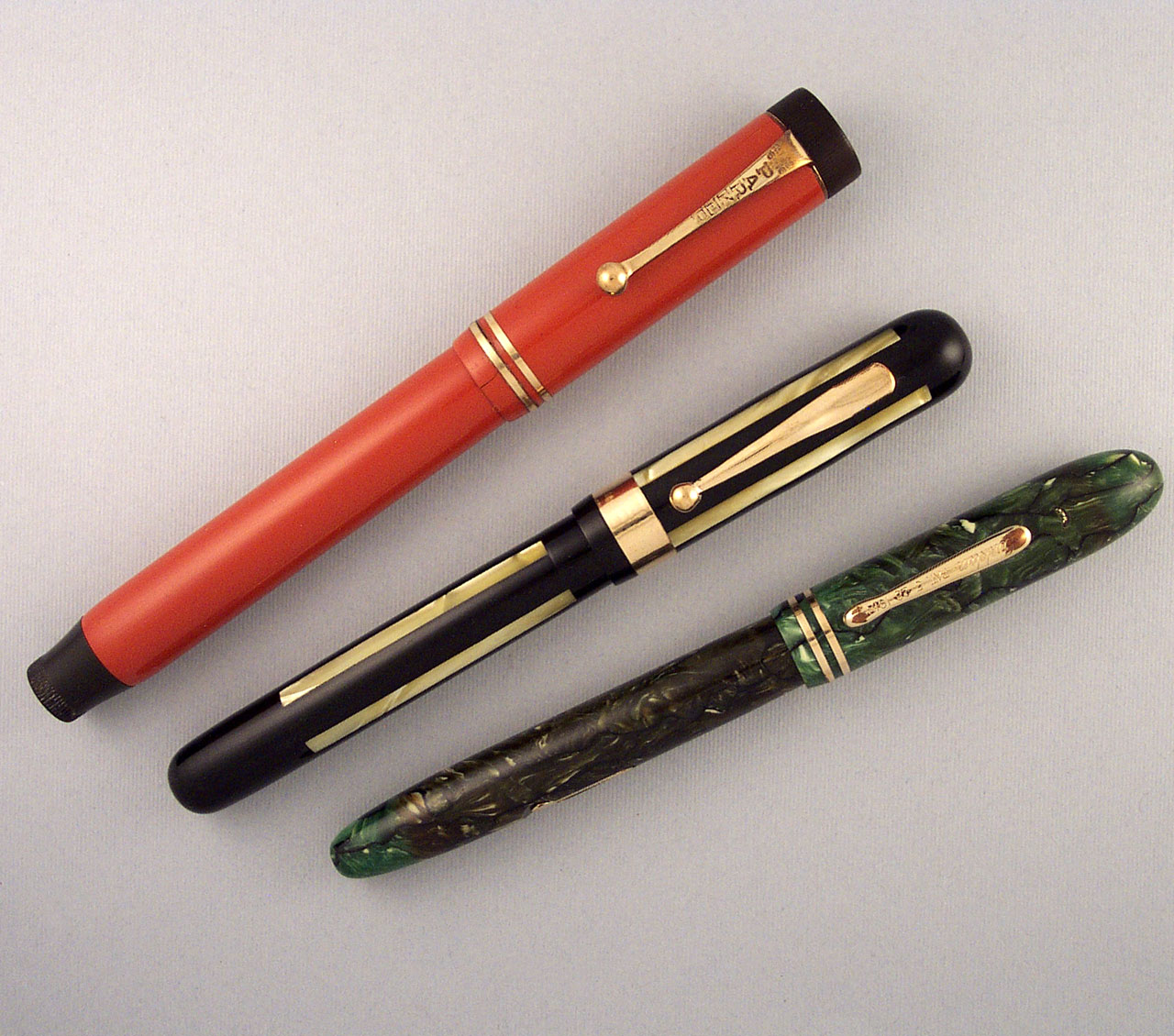 John Holland Jewel Inlaid Pearl and Black Stripe c. 1937 between a Parker Duofold and a Conklin Symetrik
John Holland Jewel Inlaid Pearl and Black Stripe c. 1937 between a Parker Duofold and a Conklin Symetrik
That is one beautiful pen! I've had the opportunity to see and use most if not all of the "most wanted" pens that show up on lists from time to time and this pen, understated as it is, is definitely eye-catching. Almost everyone who has seen it wants to look at it. It has a presence not many other pens have.
It is beautifully restored and has obviously had a lot of excellent nib work done. A very photogenic pen, too!
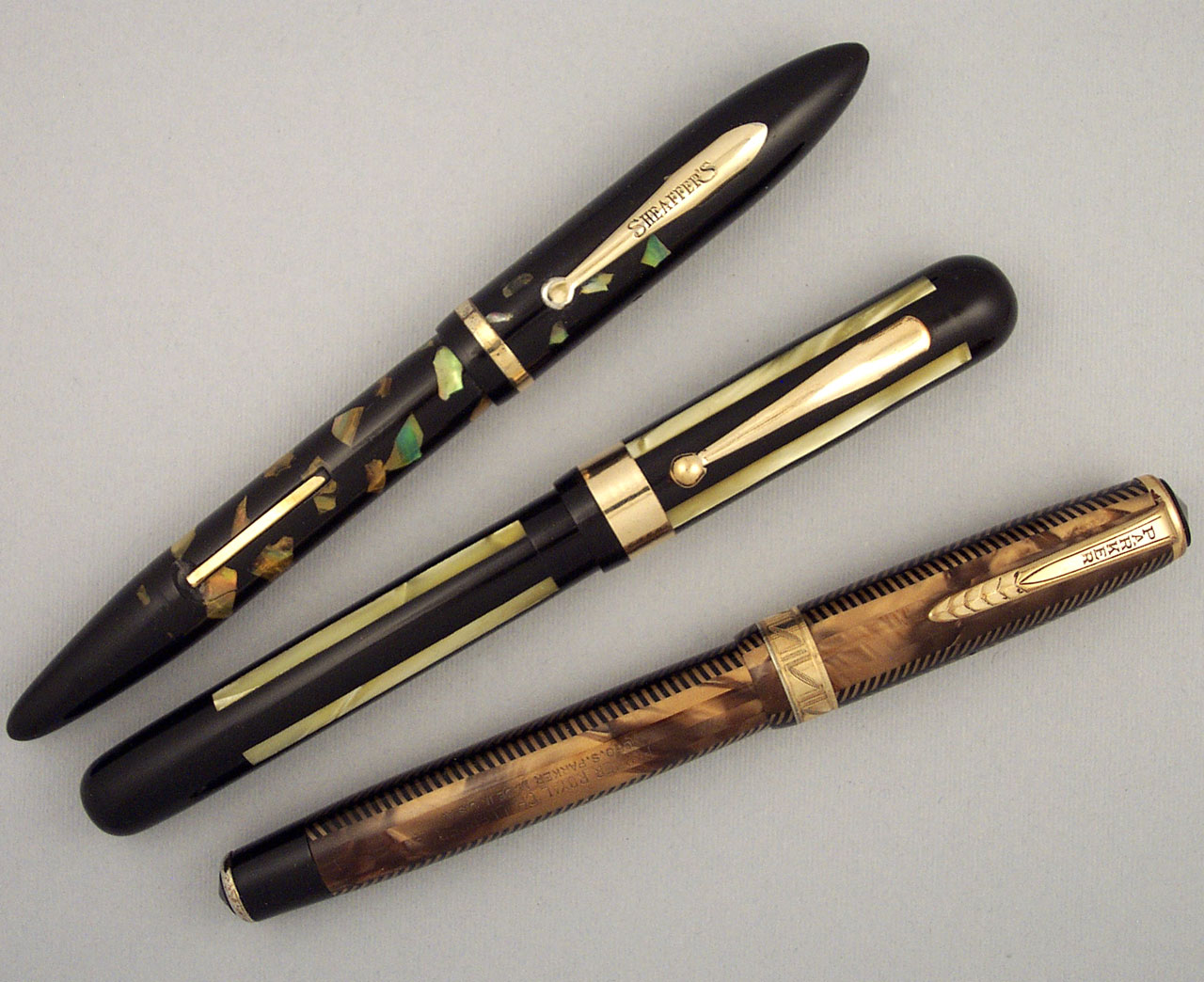 John Holland Jewel Inlaid Pearl and Black Stripe c. 1937 between a Sheaffer Balance Ebonized Pearl and a Parker Royal Challenger
John Holland Jewel Inlaid Pearl and Black Stripe c. 1937 between a Sheaffer Balance Ebonized Pearl and a Parker Royal Challenger
The pen sits high in the pocket due to the clip placement on the front of the cap. It is quite lightweight, but has a sturdy and high quality feel and tight fit and finish. It's about 5 1/8 inches long capped and 6 5/8 inches posted. It posts securely, but the barrel is long enough to write comfortably without, and I liked it better that way.
The ringtop pen is small in the hand, but still comfortable to write with, even unposted. In spite of the long tines and taper of the nib, it's a very firm and smooth writing manifold fine.
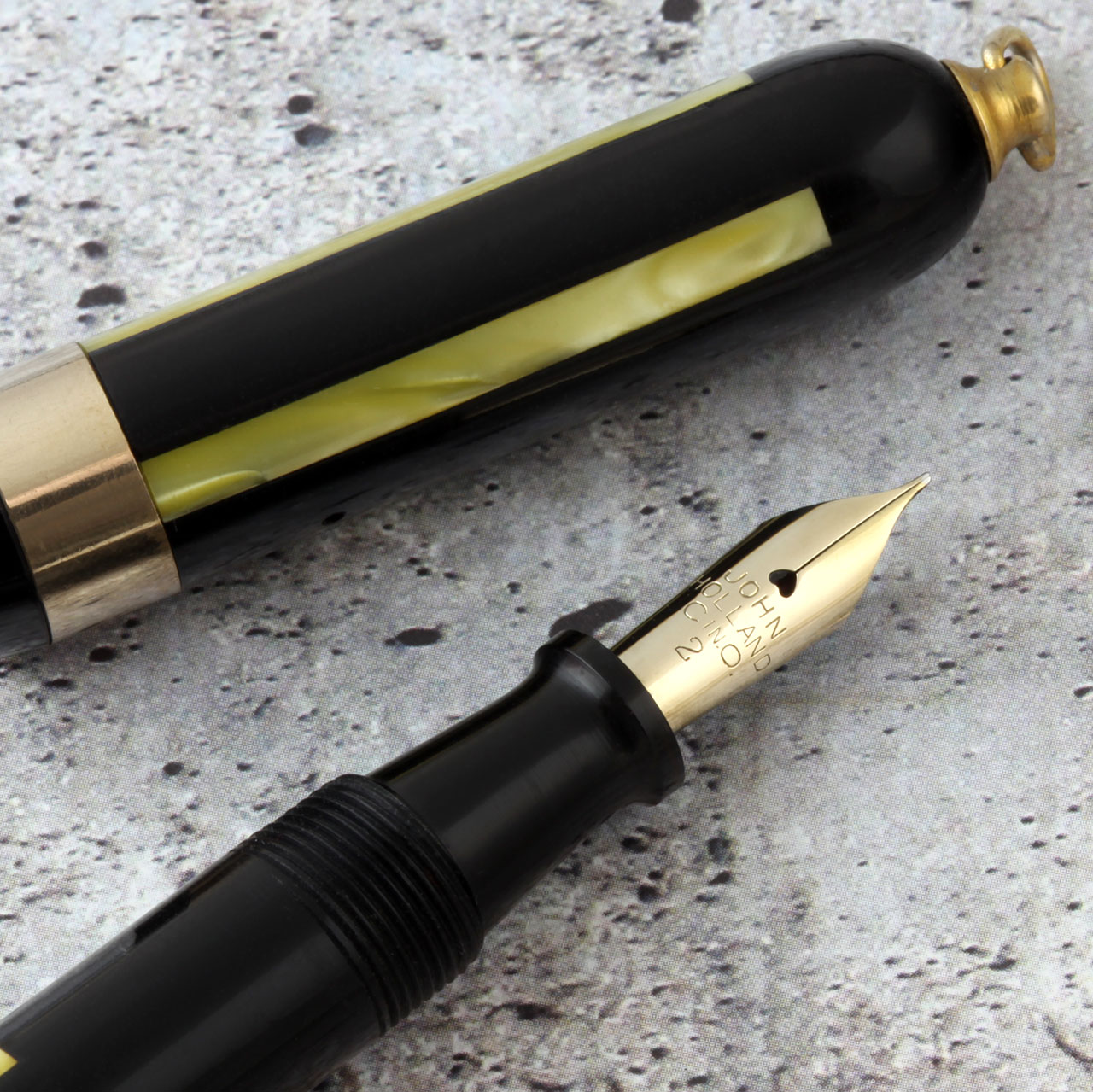 John Holland Jewel Inlaid Pearl and Black Stripe ringtop pen c. 1937, nib detail
John Holland Jewel Inlaid Pearl and Black Stripe ringtop pen c. 1937, nib detail
Being a regional manufacturer, John Holland pens are going to be quite uncommon, as opposed to the "big four". Collectors will seek out models such as this one that have unusual designs. They aren't commanding the prices of their better known contemporaries, but they will cost a premium. A pen such as these John Holland Jewel pens would make a high quality addition to any collection.
Acknowledgment
Thanks to Naphtali Hoffman for scanned images of the John Holland Jewel Inlay ringtop pen.
References
"History of John Holland," by L. Michael Fultz, Luxbid.com
Undated 1920s era John Holland catalog, marked number 130
Undated 1937 catalog, pages 165 and 166
Undated 1939 catalog, pages 156 and 157
Interact
Comments on this article may be sent to the author, Jim Mamoulides


